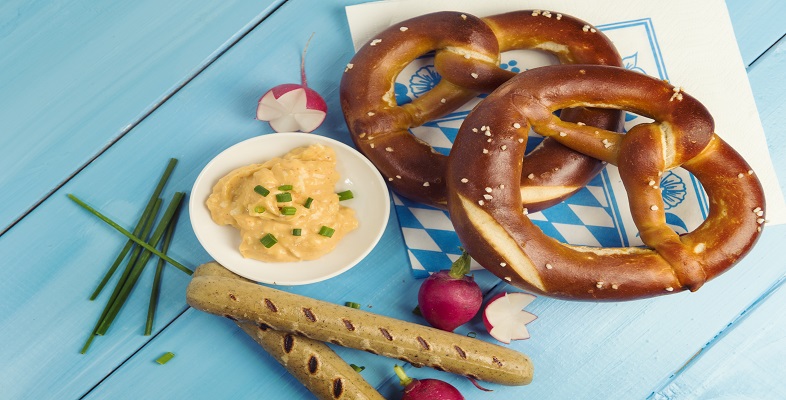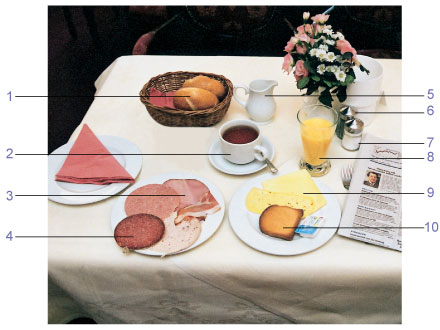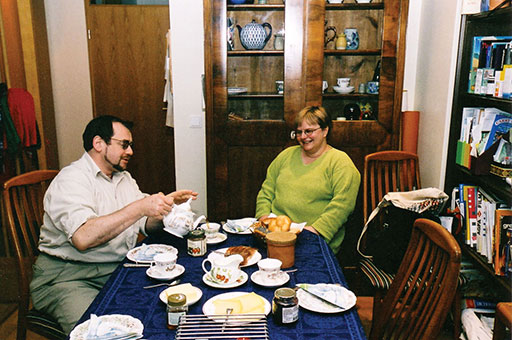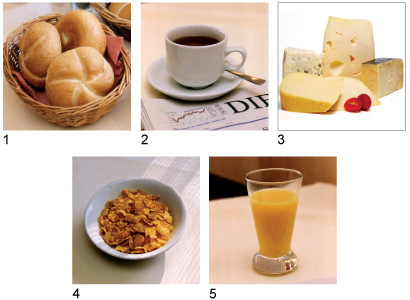1 Breakfast foods
Activity 1
This is a picture of a breakfast table with typical German breakfast foods. Look at the image and then match the label numbers to the correct food names.
Using the following two lists, match each numbered item with the correct letter.
das Brötchen
der Kaffee
der Schinken
die Wurst
die Milch
der Pfeffer
das Salz
der Orangensaft
der Käse
der Toast
a.9
b.1
c.2
d.7
e.6
f.8
g.4
h.10
i.5
j.3
- 1 = b
- 2 = c
- 3 = j
- 4 = g
- 5 = i
- 6 = e
- 7 = d
- 8 = f
- 9 = a
- 10 = h
Skills: Memorising nouns with pictures
A useful strategy for memorising nouns is to learn the words in connection with pictures until you can cover the words and name each of the items with its correct article using just the picture.
Language: Using der, die, das and ein, eine
In the first activity you came across some of the German articles der, die, das (the). Here is how they work:
These articles identify the grammatical gender of a noun. All German nouns have a grammatical gender. They are either masculine, feminine or neuter. Sometimes the gender is predictable, for example the word for man, Mann, is masculine and the word for woman, Frau, is feminine. But this is not true for a lot of nouns. They just happen to be either masculine or feminine or neuter. The article for each gender is different. The German for ‘the’ can be either der, die or das depending on the gender of the noun. Similarly, the German for ‘a/an’ can be ein or eine depending on the gender.
| ‘the’ | ‘a’ | |||
| masculine (m.) nouns | der | der Kaffee | ein | ein Kaffee |
| feminine (f.) nouns | die | die Wurst | eine | eine Wurst |
| neuter (nt.) nouns | das | das Brötchen | ein | ein Brötchen |
| all nouns in the plural | die | die Eier | – | – |
You can also see that all German nouns begin with a capital letter. Note that you may come across articles other than the ones above.
Activity 2
Now listen to three people talking about what they usually eat (essen) and drink (trinken) for breakfast (Frühstück). Don’t reach for the dictionary yet – see how much you can understand first. Note down the breakfast items you hear each person mention.
Transcript: Audio 1
Hören Sie bitte.
Answer
This table demonstrates who mentioned which items:
| Mann 1 | Mann 2 | Frau | |
| Kaffee | ✘ | ✘ | |
| Milch | ✘ | ||
| Müsli | ✘ | ✘ | |
| Ei | ✘ | ||
| Toast | ✘ | ✘ | ✘ |
| Brot | ✘ | ✘ | |
| Brötchen | ✘ | ✘ | |
| Schinken | ✘ | ||
| Käse | ✘ | ✘ | ✘ |
| Marmelade | ✘ | ✘ | ✘ |
| Jogurt | ✘ |
Culture: Traditional German breakfast foods
Did you notice that none of the interviewees in the audio clip mentioned a cup of tea? Although the couple pictured here are drinking tea, coffee is much more popular at breakfast time. Slices of cold meat or slicing sausage (Aufschnitt, Wurst), ham (Schinken) and cheese (Käse) are also very common breakfast foods, as well as hard-boiled eggs (gekochte Eier) and Marmelade, which is not just marmalade (Orangenmarmelade) but any kind of jam.
Language: Personal pronouns
Here is a list of German pronouns.
| singular | plural | singular and plural | |||
|---|---|---|---|---|---|
| ich | I | wir | we | Sie | you (when talking to one or more adults who are not very close friends or relatives of yours) |
| du | you (when talking to a close friend, a relative or a child) | ihr | you (when talking to two or more close friends, relatives or children) | ||
| er | he | sie | they | ||
| sie | she | ||||
| es | it | ||||
Note that sie with a small ‘s’ means ‘she’ and also ‘they’. Sie with a capital ‘S’ means ‘you’. There are several ways of saying ‘you’ in German (du, ihr and Sie) but Sie is the most useful for talking to German-speaking people when you meet them.
Language: The verbs essen and trinken
Here is the present tense of the irregular verb essen (to eat) and the regular verb trinken (to drink). You will see that the ending of the verb changes depending on whether it follows ich, du etc. Only the second and third person singular (du and er/sie/es) forms of essen are irregular, with a change in the vowel sound.
| essen | trinken |
|---|---|
| ich esse | ich trinke |
| du isst / Sie essen | du trinkst / Sie trinken |
| er/sie/es isst | er/sie/es trinkt |
| wir essen | wir trinken |
| ihr esst / Sie essen | ihr trinkt / Sie trinken |
| sie essen | sie trinken |
- Vokabeln (vocabulary)
- Cornflakes (pl.) cornflakes
Activity 3
Listen to the clip below, with five recorded questions about what various people have for breakfast. In the gap after the questions, answer according to the picture prompts below, replacing the person’s name each time with the appropriate personal pronoun. You may want to use the transcript to help you.
Beispiel (example)
You hear: Was isst Sara zum Frühstück?
You say: Sie isst Brötchen.
You hear: Sie isst Brötchen.
Transcript: Audio 2
Bitte hören Sie und sprechen Sie.



